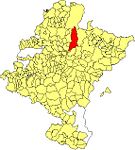Esteríbar
| Esteríbar municipality | ||
|---|---|---|
| coat of arms | Map of Spain | |

|
|
|
| Basic data | ||
| Autonomous Community : |
|
|
| Province : | Navarre | |
| Comarca : | Auñamendi | |
| Coordinates | 42 ° 57 ′ N , 1 ° 32 ′ W | |
| Height : | 619 msnm | |
| Area : | 146.77 km² | |
| Residents : | 2,702 (Jan 1, 2019) | |
| Population density : | 18.41 inhabitants / km² | |
| Postal code : | 31280 | |
| Municipality number ( INE ): | 31098 | |
| administration | ||
| Official language : | Castilian , Basque | |
| Mayor : | Francisco Javier Borda Guard (IE) | |
| Website : | www.esteribar.org/in/fr_valle.htm | |
| Location of the municipality | ||

|
||
Esteríbar is a municipality in the Basque part of the autonomous community of Navarre . The municipality consists of several localities in the Pyrenean valley of the same name .
The community and valley Esteríbar stretches along the Rio Arga and consists of 31 districts, but not all of them are now inhabited. The main town and seat of the administration is Zubiri . It lies roughly in the middle of the Esteríbar valley. The larger towns are Eugui in the upper part of the valley and Larrasoaña and Urdaniz , from Zubiri down the valley. Larrasoaña was an independent community until the 20th century. The town of Olloqui , which is closest to Pamplona , has seen a lot of construction activity in recent years, with now many villas and townhouses.
The following cities have their own local representation: Eugui ( Eugi ) Imbuluzqueta ( Inbuluzketa ) Iragui ( Iragi ) Larrasoaña , Leránoz ( Leranotz ) Saigo ( Saigots ) Sarasíbar ( Sarasibar ) Urdániz ( Urdaitz / Urdaniz ) Zabaldica ( Zabaldika ) and Zubiri . The places Agorreta , Aquerreta ( Akerreta ), Arleta , Erreà , Ezquíroz ( Ezkirotz ), Guenduláin ( Gendulain ), Idoy ( Idoi ), Ilárraz ( Ilarratz ), Ilúrdoz ( Ilurdotz ), Iroz ( Irotz ), Irure , Olloqui do not have their own local representative ( Olloki ), Ostériz ( Osteritz ), Setoáin ( Setoain ), Urtasun and Zuriáin ( Zuriain ). And the places Belzunegui ( Beltzunegi ), Idoyeta ( Idoieta ) and Zay ( Zai ) are now without a population .
history
The Esteríbar Valley was traditionally used as a passage between France and the Iberian Peninsula across the Pyrenees. This relatively easy route leads from the Pamplona basin via Esteibar along the Rio Arga into the Erro valley and on over the Ibañeta Pass to France. It is believed that the Celts took this route at the time of the Great Migration . Later the Roman road Astorga-Bordeaux ran through the valley. In the Middle Ages, the Roman Road became part of the Camino de Santiago Way of St. James . Pilgrimage reached its peak in the 12th century, when there were several pilgrimage hostels and hospices in the Esteríbar valley.
The Esteríbar Valley was first mentioned in writing in 1066 when it was donated to the Monastery of Leyre by the Monastery of San Agustin de Larrasoaña . In the early modern times, the main town of the valley is Aquerreta, where the town hall was located and where the respective mayor, who was appointed by the individual villages on a rotation basis, resided.
With the administrative reform of the 19th century, the valley received the status of a municipality. Zubri, with its central location and the largest population, becomes the main town with the seat of administration. Although located in the middle of the valley, Larrasoaña existed as an independent municipality until the 20th century, before becoming part of Esteríbar in 1928. Probably the place originated in the 10th century around the monastery of San Agustin de Larrasoain . Larrasoaña is mentioned as a good city as early as 1212.
Another place in the valley can look back on an eventful history, Eugui. An ammunition factory was founded here in 1535, which existed until the 18th century. In 1930, the largest magnesite deposit in Europe was discovered near the old factory , which was mined from 1945 onwards. This dismantling and the reservoir ( Eugui Reservoir ) created in 1970 to supply Pamplona with water have radically changed the landscape.
Population development of the municipality

Web links
Individual evidence
- ↑ Cifras oficiales de población resultantes de la revisión del Padrón municipal a 1 de enero . Population statistics from the Instituto Nacional de Estadística (population update).
